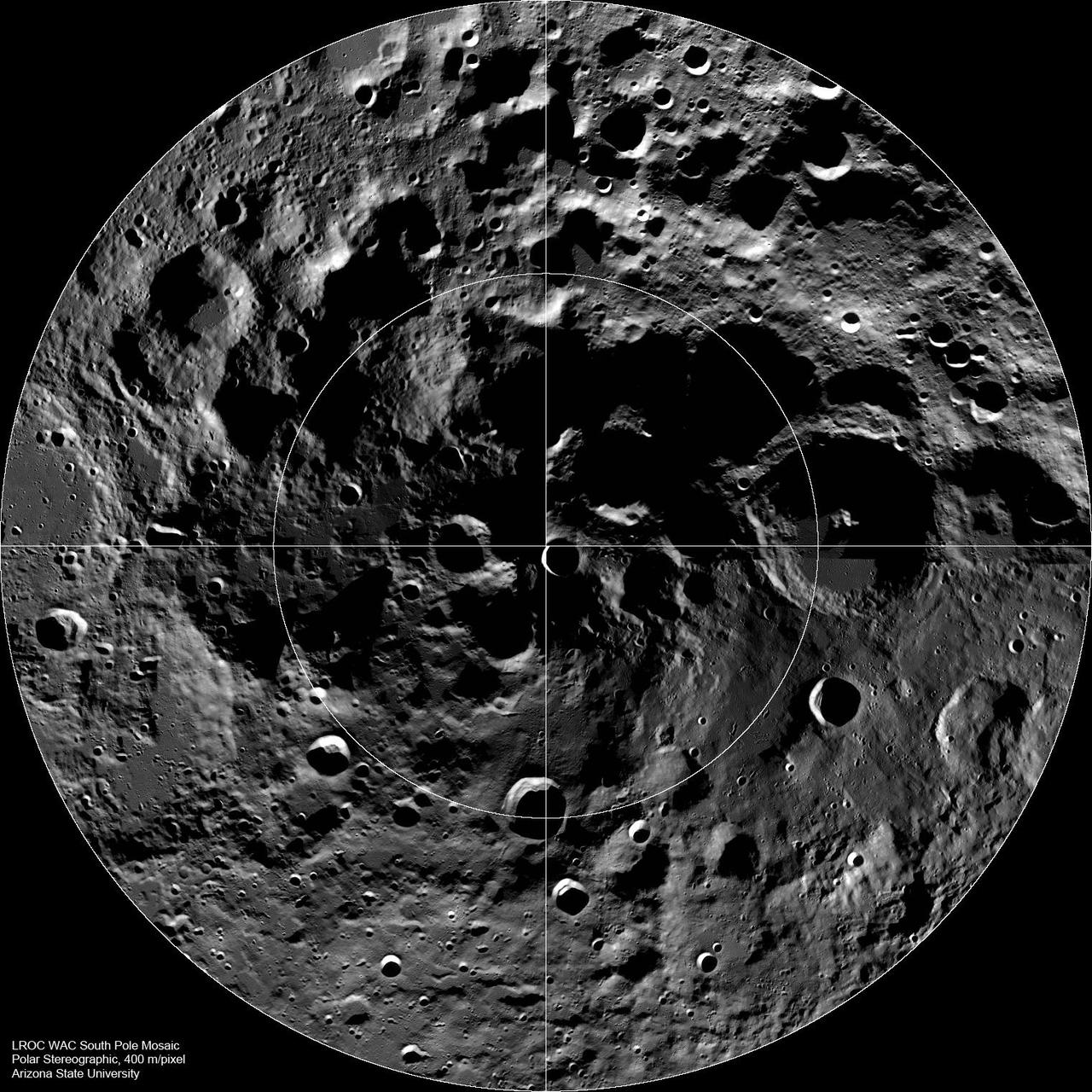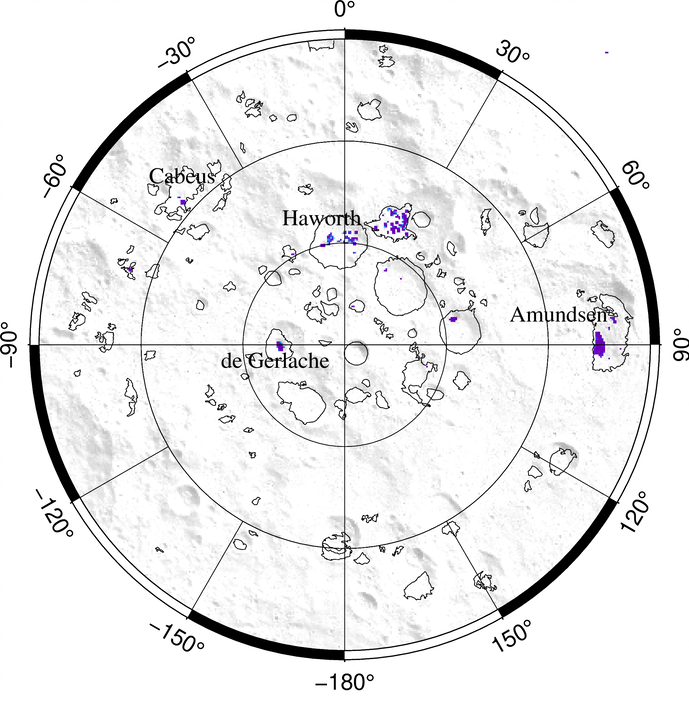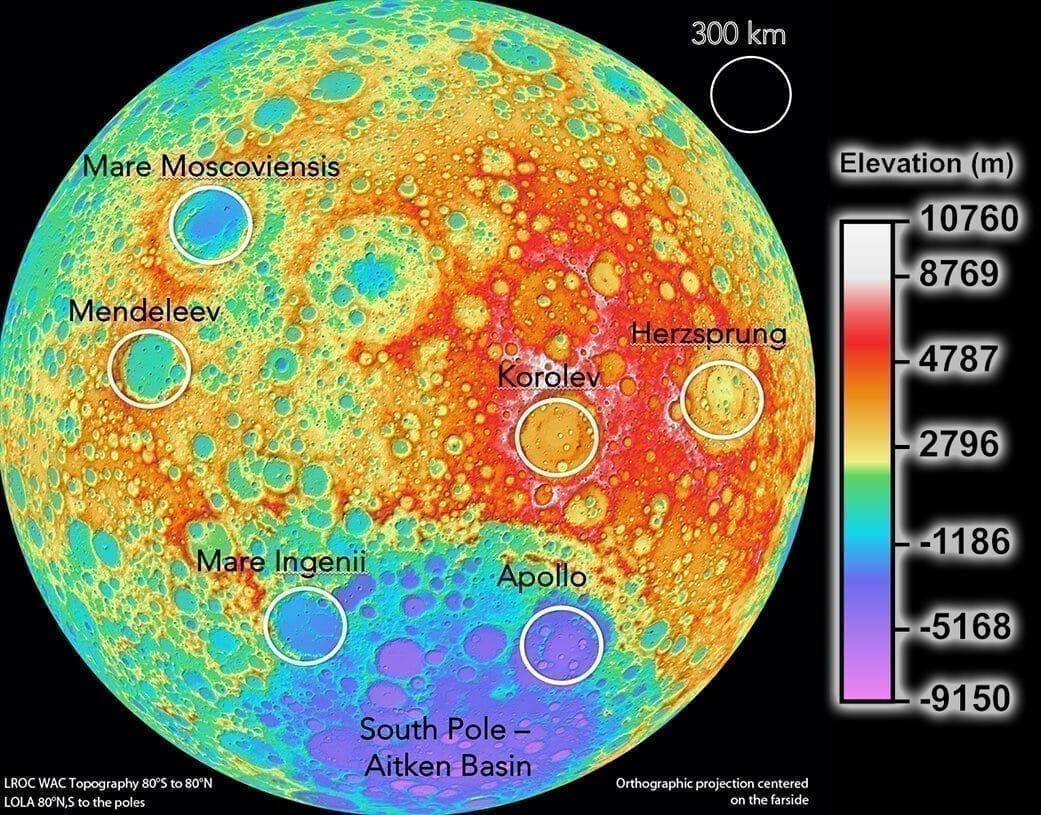
A view of the lunar south pole, where newly confirmed carbon dioxide cold traps are located, according to new research in Geophysical Research Letters. Future missions on the Moon may target this region to find out more about the resources that may exist there.
Credit: NASA/GSFC/Arizona State University
THE CO2 TRAPS LIKELY CONTAIN SOLID CARBON DIOXIDE THAT COULD BE USED TO SUSTAIN ROBOT OR HUMAN PRESENCE ON THE MOON
After decades of uncertainty, researchers have confirmed the existence of lunar carbon dioxide cold traps that could potentially contain solid carbon dioxide. The discovery will likely have a major influence in shaping future lunar missions and could impact the feasibility of a sustained robot or human presence on the moon.
In the permanently shadowed regions at the poles of our moon, temperatures dip below those in the coldest areas of Pluto, allowing for carbon dioxide cold traps. In these cold traps, carbon dioxide molecules could freeze and remain in solid form even during peak temperatures in the lunar summer.
Future human or robot explorers could use the solid carbon dioxide in these cold traps to produce fuel or materials for longer lunar stays. The carbon dioxide and other potential volatile organics could also help scientists better understand the origin of water and other elements on the moon.
Although cold traps have been predicted by planetary scientists for years, this new study is the first to firmly establish and map the presence of carbon dioxide cold traps. To find the coldest spots on the moon’s surface, researchers analyzed 11 years of temperature data from the Diviner Lunar Radiometer Experiment, an instrument flying aboard NASA’s Lunar Reconnaissance Orbiter.
The new research, published in the AGU journal Geophysical Research Letters, which publishes high-impact, short-format reports with immediate implications spanning all Earth and space sciences, shows that these cold traps include several pockets concentrated around the lunar southern pole. The total area of these carbon dioxide traps totals 204 square kilometers, with the largest area in the Amundsen Crater hosting 82 square kilometers of traps. In these areas, temperatures continually remain below 60 degrees Kelvin (about minus 352 degrees Fahrenheit.)
The existence of carbon dioxide cold traps does not guarantee the existence of solid carbon dioxide on the moon, but this verification does make it highly likely that future missions could find carbon dioxide ice there, according to the researchers.
“I think when I started this, the question was, ‘Can we confidently say there are carbon dioxide cold traps on the moon or not?’” said Norbert Schörghofer, a planetary scientist at the Planetary Science Institute and lead author on the study. “My surprise was that they’re actually, definitely there. It could have been that we can’t establish their existence, [they might have been] one pixel on a map… so I think the surprise was that we really found contiguous regions which are cold enough, beyond doubt.”
A map of carbon dioxide cold traps on the moon, with likely cold traps marked in purple hues. In these regions, temperatures dip below even the coldest temperatures measured on Pluto.
Credit: AGU/Geophysical Research Letters
MANAGING THE MOON
The existence of carbon dioxide traps on the moon will likely have implications for the planning of future lunar exploration and international policy regarding the resource.
If there is indeed solid carbon dioxide in these cold traps, it could potentially be used in a variety of ways. Future space explorers could use the resource in the production of steel as well as rocket fuel and biomaterials, which would both be essential for sustained robot or human presence on the moon. This potential has already attracted interest from governments and private companies.
Scientists could also study lunar carbon to understand how organic compounds form and what kind of molecules can be naturally produced in these harsh environments.
The carbon dioxide cold traps could also help scientists answer long-standing questions about the origins of water and other volatiles in the Earth-moon system, according to Paul Hayne, a planetary scientist at the University of Colorado, Boulder who was not involved in the study.
Carbon dioxide could be a tracer for the sources of water and other volatiles on the lunar surface, helping scientists to understand how they arrived on the moon and on Earth.
“These should be high-priority sites to target for future landed missions,” Hayne said. “This sort of pinpoints where you might go on the lunar surface to answer some of these big questions about volatiles on the moon and their delivery from elsewhere in the solar system.”
Original Article: CARBON DIOXIDE COLD TRAPS ON THE MOON ARE CONFIRMED FOR THE FIRST TIME
More from: Planetary Science Institute | University of California Los Angeles | Southern Methodist University
The Latest Updates from Bing News & Google News
Go deeper with Bing News on:
Lunar carbon dioxide cold traps
- Growth in Atmospheric Carbon Dioxide Sets 12-Month Record, Scripps Reports
The monthly average concentration of carbon dioxide in the atmosphere measured at Mauna Loa Observatory in March showed a record 12-month increase, the Scripps Institution of Oceanography announced ...
- Science news
A collaborative research team from NIMS and Tokyo University of Science has successfully developed an artificial intelligence (AI) device that executes brain-like information processing through ...
- Forests trap less carbon than before, EPA says
In its annual report on greenhouse gases by sector, the agency said forests sequestered 787 million metric tons of carbon dioxide equivalent in 2022, down from 844.2 million metric tons the prior ...
- Carbon Dioxide Battery Breakthrough
Mr. Beast initiative: https://teamtrees.org--- About ColdFusion ---ColdFusion is an Australian based online media company ...
- The history of the young cold traps of the asteroid Ceres
For these reasons, temperatures are not as low on Ceres than they are on parts of the lunar surface ... History of Ceres's Cold Traps Based on Refined Shape Models, The Planetary Science Journal ...
Go deeper with Google Headlines on:
Lunar carbon dioxide cold traps
[google_news title=”” keyword=”lunar carbon dioxide cold traps” num_posts=”5″ blurb_length=”0″ show_thumb=”left”]
Go deeper with Bing News on:
Future lunar missions
- NASA details plan to build a levitating robot train on the moon
NASA's plan to build a train track on the moon is part of the agency's Innovative Advanced Concepts program, which aims to develop "science fiction-like" projects for future space exploration.
- Can we grow plants on Moon? NASA's Artemis III mission plans to study possibilities; all you need to know
NASA's Artemis III mission in 2026 aims to explore plant growth in the lunar environment using the Lunar Effects on Agricultural Flora (LEAF) payload. The success of the mission could lead to ...
- What Is Polaris Dawn? Breaking Down the Upcoming SpaceX Mission
The crewed spaceflight, which will launch no earlier than this summer, receives a major boost with the reveal of SpaceX’s new spacesuit.
- NASA watchdog report: 100+ cracks on heat shield biggest threat to human moon mission
“Should the same issue occur on future Artemis missions, it could lead to the loss of the vehicle ... The test flight with four astronauts will travel to the moon and back without landing. The goal is ...
- It’s Time for a Nature Preserve—On the Moon
The far side of the moon holds the keys to the future of radio astronomy. We must maintain its pristine silence to benefit everyone ...
Go deeper with Google Headlines on:
Future lunar missions
[google_news title=”” keyword=”future lunar missions” num_posts=”5″ blurb_length=”0″ show_thumb=”left”]











